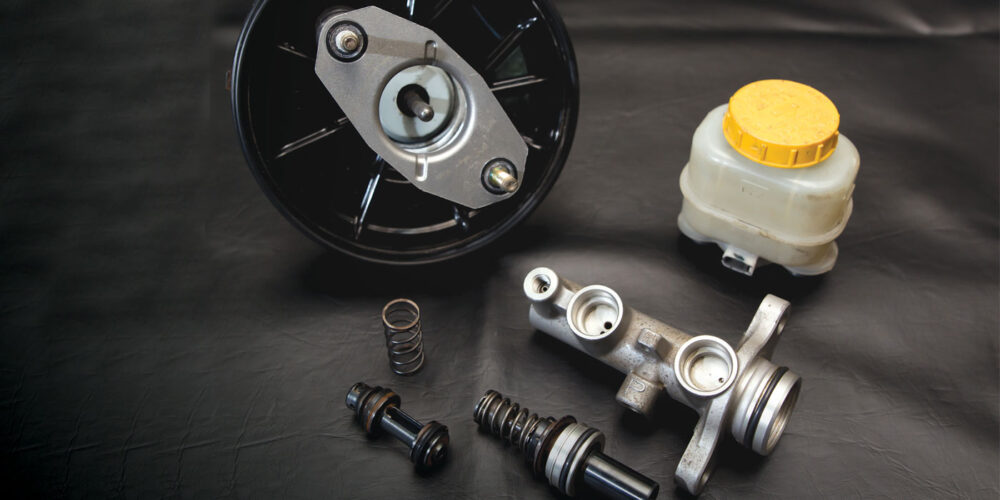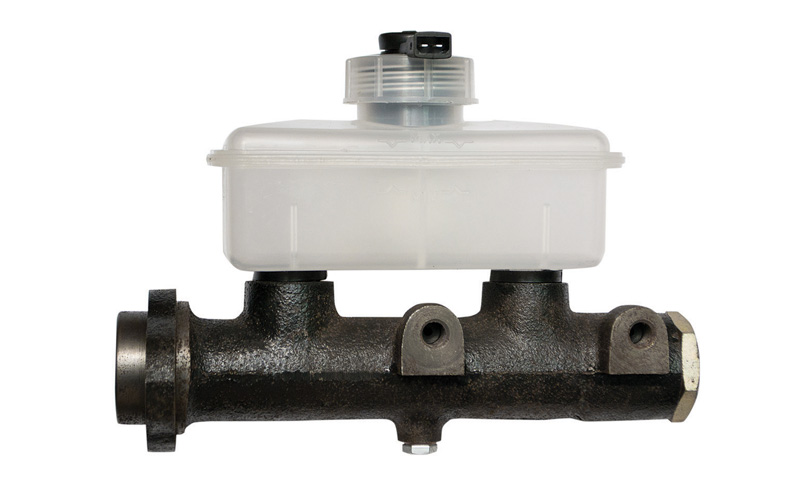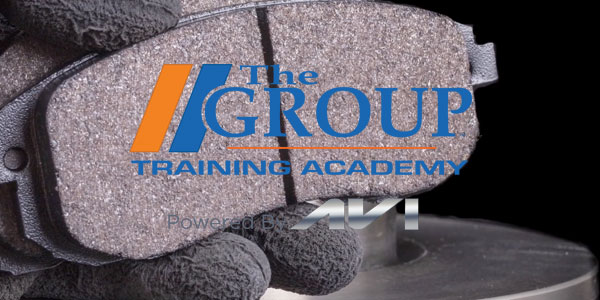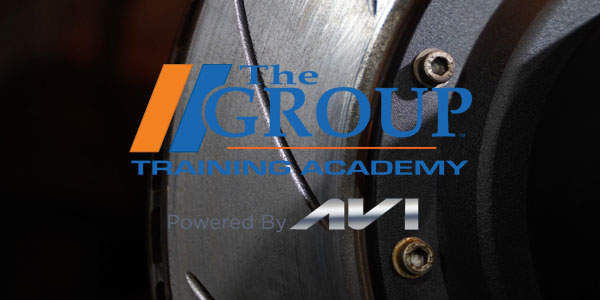Brake master cylinders convert the force exerted on the brake pedal into hydraulic force that is transmitted to the individual brake hydraulic cylinders located at each wheel. Their basic operation is easy to understand, but before getting into that, let’s look at how impressive the brake system actually is.
Have you ever tried to stop a car that rolls unexpectedly down an incline, even an incredibly slight one? It’s not easy. As a matter of fact, most of the time, you just get out of the way and hope it doesn’t hit anything before it stops. Cars are heavy. We’re not strong enough to stop them, even with all our might.
So how is it we’re able to stop them with one foot and the brake pedal? It’s not because we’re that strong. It’s because of hydraulics, the basis for brake-system operation. The theory of hydraulics states that the pressure exerted anywhere on an enclosed liquid is transmitted equally in all directions.
A visual representation can make it easier to understand. Figure 1 shows a cylinder with a piston that has a surface area of 1 square inch. Five pounds of force are being exerted on the end of the piston, which creates 5 pounds per square inch (psi) of pressure inside the system. Since liquid doesn’t compress, that pressure is transmitted equally to all interior surfaces of the cylinder.
That same 5 psi travels through the line into the larger cylinder that has a piston with a surface area of 10 square inches. Since the pressure is transmitted equally to all surfaces, 5 psi is being applied to each square inch of the larger piston, and multiplying the pressure by the area gives the output of the larger piston. This is what allows master cylinders to be relatively small, yet a brake system to be so powerful.
How Do They Work?
The primary parts of any master cylinder are the reservoir, the body and the piston(s). The reservoir can be made of cast iron, aluminum or plastic; the bodies will be cast iron or aluminum. Cast-iron or aluminum reservoirs are usually cast together with the body of the master cylinder, making them appear as one single piece. This is the original type of master cylinder on most “classic” cars.
When plastic reservoirs are used, they typically sit directly on top of the master cylinder, but they also can be mounted remotely if there’s no room, with a hose leading to the master cylinder.
The piston is located in a bore within the body of the master cylinder, and when the brake pedal is depressed, the force on the piston pressurizes the brake fluid and pushes it through the lines. A series of valves and ports further controls the flow and return of the fluid inside the master cylinder.
For many years, master cylinders were of the single-piston type, meaning only one piston pushed the fluid to all four wheels. The problem with this design was if there was a pressure loss anywhere in the system, there was a complete loss of brakes.
By the late 1960s, dual-piston master cylinders were mandatory on all new cars. A dual-piston master cylinder has two separate braking circuits, which can be split diagonally or front to rear, but either way, the important factor is you can still stop the car with a pressure loss on one circuit.
Whether it’s a diagonal or front-to-rear split depends on the vehicle. For example, a front-to-rear split is acceptable on vehicles with an even front-to-rear weight division, but when most of the vehicle weight is in front – such as on a front-wheel-drive vehicle – the system is split diagonally, since the rear brakes alone wouldn’t be enough to stop the vehicle.
Maintenance
One school of thought says there’s no actual maintenance on the master cylinder, and this is loosely correct. However, regularly flushing the brake fluid is routine maintenance that not only maintains proper braking, but also will extend the life of all brake components, including the master cylinder. Due to the corrosive nature of brake fluid – which gets worse the older it gets and the greater amount of moisture it absorbs – the seals, valves, piston and bore inside a master cylinder are easily damaged by dirty fluid.
Signs of Trouble
There are some telltale signs of a failing master cylinder. The first one is a slow fluid loss with no outwardly visible leak. The only possible location for an external leak is at the rear of the bore, where the pistons slide in during assembly. It’s often hard to see a leak, since the fluid leaks out the back into the brake booster or inside the vehicle when the master cylinder is mounted to the firewall. If there is regular fluid loss but no external leaks can be seen, look closely at this area.
Brake fluid damages paint, and a close inspection usually shows softened paint around the mounting ears of the master cylinder, indicating a leak. In some cases, you may have to unbolt the master cylinder to inspect it for leaks. Occasionally, the seals between the reservoir and master cylinder can leak as well, but these are usually available separately.
If the brake pedal slowly sinks to the floor when you’re pressing on it, this indicates fluid is leaking internally past the piston seals and the master cylinder must be replaced. Eventually, this will lead to complete failure of the master cylinder, resulting in a pedal that goes completely to the floor and no brakes.
If a brake system experiences a sudden loss of braking force and the pedal goes to the floor, this generally indicates a broken brake line or hose, which also will be evident by rapid loss of fluid. Master cylinders themselves rarely exhibit sudden failure. They almost always give warning in the way of slow leaks or slow leak-down of the brake pedal, which means it’s time to replace.
Replacement
When your customer is installing a new master cylinder, they’ll need brake fluid first and foremost, and they may ultimately need a lot more when they go to bleed the system if they find bleeder screws that won’t open.
However, the most important advice you can give them is to bench-bleed the master cylinder following the instructions and using the bleeding hardware that comes with it. You can assure them it’s a simple and quick process, but a potential nightmare if they don’t. This is also one of the most important times to use a fender cover. Even the slightest drop of brake fluid on the paint will begin to etch into it immediately, and it’s a quick and easy way to avoid it.















